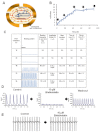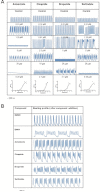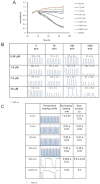Dynamic monitoring of beating periodicity of stem cell-derived cardiomyocytes as a predictive tool for preclinical safety assessment
- PMID: 21838757
- PMCID: PMC3372727
- DOI: 10.1111/j.1476-5381.2011.01623.x
Dynamic monitoring of beating periodicity of stem cell-derived cardiomyocytes as a predictive tool for preclinical safety assessment
Abstract
Background and purpose: Cardiac toxicity is a major concern in drug development and it is imperative that clinical candidates are thoroughly tested for adverse effects earlier in the drug discovery process. In this report, we investigate the utility of an impedance-based microelectronic detection system in conjunction with mouse embryonic stem cell-derived cardiomyocytes for assessment of compound risk in the drug discovery process.
Experimental approach: Beating of cardiomyocytes was measured by a recently developed microelectronic-based system using impedance readouts. We used mouse stem cell-derived cardiomyocytes to obtain dose-response profiles for over 60 compounds, including ion channel modulators, chronotropic/ionotropic agents, hERG trafficking inhibitors and drugs known to induce Torsades de Pointes arrhythmias.
Key results: This system sensitively and quantitatively detected effects of modulators of cardiac function, including some compounds missed by electrophysiology. Pro-arrhythmic compounds produced characteristic profiles reflecting arrhythmia, which can be used for identification of other pro-arrhythmic compounds. The time series data can be used to identify compounds that induce arrhythmia by complex mechanisms such as inhibition of hERG channels trafficking. Furthermore, the time resolution allows for assessment of compounds that simultaneously affect both beating and viability of cardiomyocytes.
Conclusions and implications: Microelectronic monitoring of stem cell-derived cardiomyocyte beating provides a high throughput, quantitative and predictive assay system that can be used for assessment of cardiac liability earlier in the drug discovery process. The convergence of stem cell technology with microelectronic monitoring should facilitate cardiac safety assessment.
© 2011 ACEA Biosciences Inc. British Journal of Pharmacology © 2011 The British Pharmacological Society.
Figures







References
-
- Arrigoni C, Crivori P. Assessment of QT liabilities in drug development. Cell Biol Toxicol. 2007;23:1–13. - PubMed
-
- Atienza JM, Yu N, Kirstein SL, Xi B, Wang X, Xu X, et al. Dynamic and label-free cell-based assays using the real-time cell electronic sensing system. Assay Drug Dev Technol. 2006a;4:597–607. - PubMed
-
- Atienza JM, Yu N, Wang X, Xu X, Abassi Y. Label-free and real-time cell-based kinase assay for screening selective and potent receptor tyrosine kinase inhibitors using microelectronic sensor array. J Biomol Screen. 2006b;11:634–643. - PubMed
MeSH terms
Substances
LinkOut - more resources
Full Text Sources
Other Literature Sources

